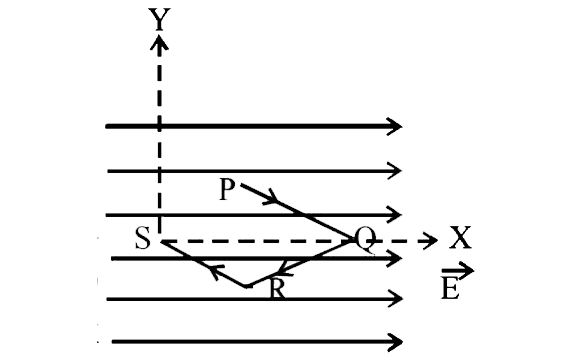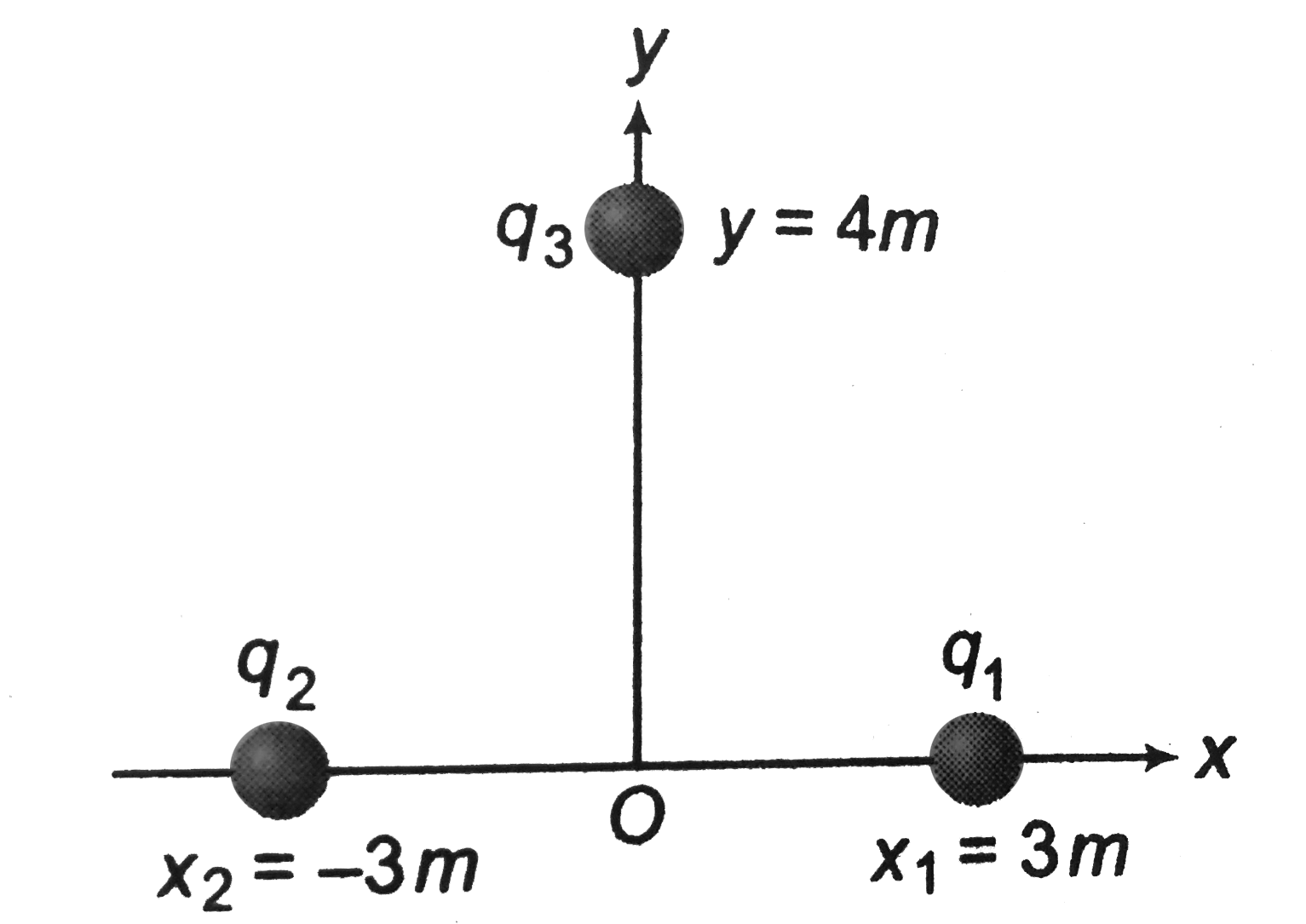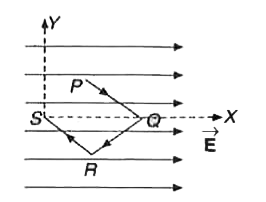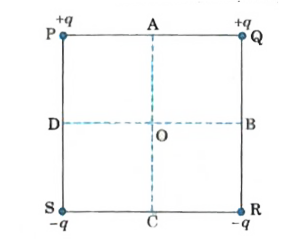A point charge q moves from point P to pont S along the path PQRS (fig.) in a uniform electric field E pointing parallel to the poistive direction of the X-axis. The coordinates of the points P, Q, R and S are(a, b, O), (2a, O, O)(a, -b,O––) and (O, O, O) respectively. The work done by the field in the above process is given by the expresison............

Since electric field is conservative in nature, the work done by the field along PQRS will be the same as alo9ng p to M to S
Work done from P to to M=→F,¯¯¯PM=F(PM)cos90∘=0

Work done from M to S=→F,¯¯¯¯MS=F(MS)cos180∘=−qEa
Topper's Solved these Questions
- MISCELLANEOUS VOLUME 3BOOK - CENGAGE PHYSICSCHAPTER - MISCELLANEOUS VOLUME 3EXERCISE - True and False Type
5 Videos
- MISCELLANEOUS VOLUME 3BOOK - CENGAGE PHYSICSCHAPTER - MISCELLANEOUS VOLUME 3EXERCISE - Assertion-Reasoning Type
1 Video
- MISCELLANEOUS VOLUME 3BOOK - CENGAGE PHYSICSCHAPTER - MISCELLANEOUS VOLUME 3EXERCISE - Interger Answer type
20 Videos
- MECHANICAL PROPERTIES OF SOLIDSBOOK - CENGAGE PHYSICSCHAPTER - MECHANICAL PROPERTIES OF SOLIDSEXERCISE - Question Bank
4 Videos
- MISCELLANEOUS VOLUME 5BOOK - CENGAGE PHYSICSCHAPTER - MISCELLANEOUS VOLUME 5EXERCISE - Integer
12 Videos
Similar Questions
The work done in carrying a point charge form one point to another in an electrostatic field depends on the path along which the point charge is carried.
View SolutionSTATEMENT-1: For practical purposes, the earth is used as a reference at zero potencial in electrical circuits. and
STATEMENT-2: The electrical potential of a sphere of radius R with charge Q uniformly distributed on the surface is given by Q4πε0R.
View SolutionTwo point charges q1=q2=2μC are fixed at x1=+3m and x2=−3m as shown in figure. A third particle of mass 1 g and charge q3=−4μC are released from rest at y=4.0m.Find the speed of the particle as it reaches the origin.

View SolutionThe diameter of a brass rod is 4 mm and Young's modulus of brass is 9×1010N/m2. The force required to stretch by 0.1 % of its length is
View SolutionA charged particle enters a uniform magnetic field with velocity v0=4m/s perpendicular to it, the length of magnetic field is x=(√32)R, where R is the radius of the circular path of the particle in the field. Find the magnitude of charge in velocity (in m/s) of the particle when it comes out of the field.
View SolutionA point charge q moves from point P to pont S along the path PQRS (fig.) in a uniform electric field E pointing parallel to the poistive direction of the X-axis. The coordinates of the points P, Q, R and S are(a, b, O), (2a, O, O)(a, -b,O––) and (O, O, O) respectively. The work done by the field in the above process is given by the expresison............

View SolutionA positive point charge q is carried from a point B to a point A in the electric field of a point charge +Q at O. If the permittivity of free space is epsi_0 , the work done in the process is given by (where a = OA and b = OB ) -
View Solutionएक बिन्दु आवेश q एकसमान वैद्युत क्षेत्र E में जो X-अक्ष की धनात्मक दिशा के समान्तर है, बिन्दु P से बिन्दु S तक पथ PQRS के अनुदिश चलता है। बिन्दुओं P, Q, R व S के निर्देशांक क्रमश: (a,b, 0), (2a ,-b, 0), (a, -b, 0) तथा (0, 0, 0) हैं। इस प्रक्रिया में क्षेत्र द्वारा किये गये कार्य का व्यंजक ............है।

View SolutionThere is a, and four charges +q, +q, -q and -q are fixed at the four corners of square. See the figure for the placement of charges.
Calculate:
(i) Electric potential at point O.
(ii) Work done to move a charge +e from point O to point B.
(iii) Work done to move a charge +e from point O to A.

View Solutionएक धनात्मक बिन्दु आवेश q एक बिन्दु B से बिन्दु A तक O पर रखे +Q बिन्दु आवेश के वैद्युत क्षेत्र में आता है। यदि निर्वात की वैद्युतशीलता ε0 है तो इस प्रक्रम में किया गया कार्य है (जहाँ, a=OA तथा b=OB)
View SolutionABCD is a tetrahedron and O is any point. If the lines joining O to the vertices meet the opposite faces at P,Q,RandS, prove that OPAP+OQBQ+ORCR+OSDS=1.
View SolutionIf →PO+→OQ=→QO+→OR, show that the point, P,Q,R are collinear.
View SolutionIn Fig. 4.34, A, B and C are points on OP, OQ and OR respectively such that ABPQ and BCQR . Show that ACPR . (FIGURE)
View SolutionIn Fig. PQ is tangent at a point R of the circle with centre O . If ∠TRQ=30o , find ∠PRS . (FIGURE)
View SolutionA point charge q moves from .P. to .S. along path PQRS in a unifrom electric field E directed parallel to positive X-axis. The co-ordinates of the points P,Q and S are (a,b,0), (2a,0,0),(0-b,(0) and (0,0,0) respectively The work done by field an the above process is given by
View SolutionA point charge q moves from .P. to .S. along path PQRS in a unifrom electric field E directed parallel to positive X-axis. The co-ordinates of the points P,Q and S are (a,b,0), (2a,0,0),(0-b,(0) and (0,0,0) respectively The work done by field an the above process is given by
View Solution
